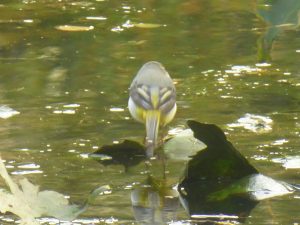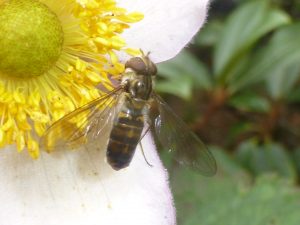
Rear-end view of Grey Wagtail, Motacilla cinerea, on Chinese Hillside pond, 8 October 2014. Photo Robert Mill.
The first three weeks of October 2014 continued the warm theme of recent months but the weather broke in the final ten days or so when it was much wetter and stormy, with the Garden being closed on at least two days. Five more species were added to the Garden’s list during October, bringing it up from 727 to 732. Two of them were leaf-mining moths, two were leaf-mining flies, and one an aphid.
Birds Thirty-six species of bird were recorded at RBGE in October, which was a much better month for birds than were July, August and September. Some notable sightings included Buzzard (twice: 10th and 27th, with two present on the first occasion), a male Kingfisher on the Pond on four days (15th, 20th, 21st, 24th), Raven once (10th) and a relatively early ‘winter’ record of Woodcock on 30th. Woodcock is very infrequently recorded in the Garden, with most sightings being in mid-winter. Grey Wagtail regularly frequented the Pond as is often the case in autumn; single individuals were seen on seven dates. There were still no definite records of ‘winter thrushes’ such as Fieldfare and Redwing although the presence of the latter in the yews around the Pond was suspected on a few dates in the second half of the month. The full list of bird species recorded at the Edinburgh Garden in September was: Blackbird, Blackcap, Black-headed Gull, Blue Tit, Bullfinch, Buzzard, Carrion Crow, Chaffinch, Coal Tit, Dunnock, Feral Pigeon, Goldcrest, Goldfinch, Great Spotted Woodpecker, Great Tit, Greenfinch, Grey Heron, Grey Wagtail, Herring Gull, Jackdaw, Kingfisher, Long-tailed Tit, Magpie, Mallard, Mistle Thrush, Moorhen, Pink-footed Goose, Raven, Robin, Song Thrush, Sparrowhawk, Tawny Owl, Tree Creeper, Wood Pigeon, Woodcock, Wren. My thanks to Robert Unwin and others for a few of the rarer species records and to Tamar Duncan and others for records in the last ten days when I was on annual leave.
Butterflies — Red Admiral continued to be recorded until the middle of the month, with four sightings between 1st and 15th. Peacock was recorded once (7th).
Moths — Several species of leaf-mining moth were identified from their mines, with two being new Garden records: Coptotriche heinemanni on 9th and Cnephasia incertana on 13th.
Other insects – Honey Bees, Buff-tailed Bumblebees and Common Wasps remained active until at least 20th when the weather became poorer but possibly the last record of Common Carder Bee for 2014 was on 8th. Alder Sawfly was identified from its leaf mine on 10th.
Six species of hoverflies were recorded in October. As in September the two most frequently sighted were Common Banded Hoverfly, Syrphus ribesii and the drone fly Eristalis tenax (six days each). Eupeodes corollae was seen twice (7th and 15th), while there were two sightings of Marmalade Hoverfly (both on 16th, one of them being of an extremely dark-coloured, almost blackish morph on Japanese Anemone that had me puzzled for quite some time; see picture) and another drone fly, Eristalis pertinax (15th).
Bugs continued to be seen regularly, with six species recorded. There were three sightings of Common Flower Bug (8th, 16th and 17th) and one each of Birch Shield Bug, Birch Catkin Bug and Hawthorn Shield Bug. Periphyllus aceris, an aphid found on maple, was a new Garden record. Other as yet still unidentified aphids were seen inside florets of members of the Asteraceae (daisy family) in the Demonstration Garden. Pine Ladybird was seen once (20th). Twelve species of leaf-mining fly were identified from their mines, with Agromyza nana (on clover) and Ophiomyia cunctata (on dandelion; both recorded on 7th) being new Garden records although both are apparently common species.


1 Comment
1 Pingback